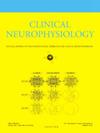癫痫和呼吸:周周呼吸障碍的教训
IF 3.6
3区 医学
Q1 CLINICAL NEUROLOGY
引用次数: 0
摘要
病理性神经系统疾病(如癫痫发作)会扰乱呼吸。初期呼吸改变包括中枢性或阻塞性呼吸暂停、呼吸急促、呼吸缓慢、低通气和低氧血症。发作性中枢呼吸暂停(ICA)已被描述与局灶性癫痫发作有关,特别是时间起源,发生在36%-40%的发作事件中。较长的ICA持续时间通常会导致低氧血症,在33-41%的病例中观察到。PCCA(惊厥后中枢性呼吸暂停)与全身性癫痫发作有关,提示全身性强直-阵挛性发作(GTC)后脑干功能障碍。人们对周周呼吸障碍的关注日益增加,因为它们与癫痫猝死(SUDEP)的潜在关联,而癫痫猝死是癫痫患者(PWE)死亡的主要原因。最近的研究强调围周呼吸症状是SUDEP风险的关键因素。鉴于证据越来越多,需要对实验和临床研究的结果进行综合评价。最近的颅内脑电图和神经影像学研究为ICA和PCCA的神经生理、结构和功能相关性以及它们与SUDEP的可能联系提供了新的见解。本文探讨了围周呼吸障碍的电临床特征和病理生理学,总结了当前的神经影像学数据,并讨论了它们对SUDEP风险和潜在治疗策略的影响。本文章由计算机程序翻译,如有差异,请以英文原文为准。
Seizures and breathing: lessons from peri-ictal respiratory disturbances
Breathing can be disrupted by pathological neurological conditions, such as seizures. Ictal respiratory changes comprise central or obstructive apnea, tachypnea, bradypnea, hypoventilation, and hypoxemia. Ictal central apnea (ICA) has been described in association with focal seizures, especially of temporal origin, occurring in 36%–40% of ictal events. Longer ICA duration typically produces hypoxemia, being observed in 33–41% of cases. PCCA (post-convulsive central apnea) has been described in relation to generalized seizures, suggesting brainstem dysfunction following a generalized tonic-clonic seizure (GTC). Growing interest in peri-ictal respiratory disturbances stems from their potential association with sudden unexpected death in epilepsy (SUDEP), the leading cause of mortality in people with epilepsy (PWE). Recent research has highlighted peri-ictal respiratory symptoms as a key factor in SUDEP risk. Given the expanding body of evidence, a comprehensive review is needed to synthesize findings from experimental and clinical studies. Recent intracranial EEG and neuroimaging research has provided new insights into the neurophysiological, structural, and functional correlates of ICA and PCCA, as well as their possible link with SUDEP. This narrative review explores the electroclinical features and pathophysiology of peri-ictal respiratory disturbances, summarizes current neuroimaging data, and discusses their implications for SUDEP risk and potential treatment strategies.
求助全文
通过发布文献求助,成功后即可免费获取论文全文。
去求助
来源期刊

Clinical Neurophysiology
医学-临床神经学
CiteScore
8.70
自引率
6.40%
发文量
932
审稿时长
59 days
期刊介绍:
As of January 1999, The journal Electroencephalography and Clinical Neurophysiology, and its two sections Electromyography and Motor Control and Evoked Potentials have amalgamated to become this journal - Clinical Neurophysiology.
Clinical Neurophysiology is the official journal of the International Federation of Clinical Neurophysiology, the Brazilian Society of Clinical Neurophysiology, the Czech Society of Clinical Neurophysiology, the Italian Clinical Neurophysiology Society and the International Society of Intraoperative Neurophysiology.The journal is dedicated to fostering research and disseminating information on all aspects of both normal and abnormal functioning of the nervous system. The key aim of the publication is to disseminate scholarly reports on the pathophysiology underlying diseases of the central and peripheral nervous system of human patients. Clinical trials that use neurophysiological measures to document change are encouraged, as are manuscripts reporting data on integrated neuroimaging of central nervous function including, but not limited to, functional MRI, MEG, EEG, PET and other neuroimaging modalities.
 求助内容:
求助内容: 应助结果提醒方式:
应助结果提醒方式:


